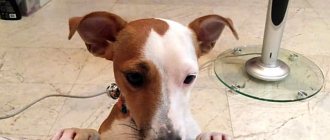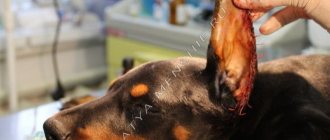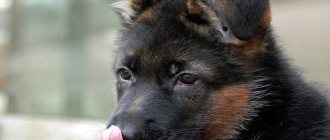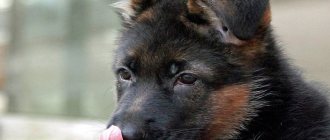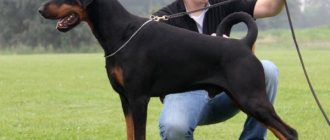Ear cropping for representatives of the Staffordshire Terrier breed is an open and debatable issue. Some are in favor, citing the traditional appearance of dogs, while others are sharply against it and consider it abuse of the animal. This is a traditional procedure that was considered mandatory for tens, if not hundreds of years, but the new century has made its own adjustments.
At the moment, the standard allows the animal to have a full-fledged ear, so cosmetic surgery to shorten it and give it a certain shape has become a personal choice of the breeder.
Postoperative care
In order for the Staffordshire Terrier to recover quickly and the operation to give the desired result, it is worth following a number of recommendations.
Ear collar
Since the wound itches as it heals, it is important to prevent scratching. For such purposes, a special collar is used that is put on the dog. It is advised to wear it until the wound heals. After this, the itching goes away and the device can be removed. The collar is made of durable multilayer polyethylene, cardboard or plastic. They are easy to find in a veterinary pharmacy or pet store. The shape of the product can be round or curved.
Daily cleaning of seams with a tampon
To prevent the wound from festering, daily treatment with an antiseptic is required to prevent infection. This could be chlorhexidine or hydrogen peroxide. The crusts that appear are soaked and removed. Also, be careful not to get dust on your ears.
Walking a puppy in dry weather
Don't forget about walking your pet. The dog needs fresh air for a speedy recovery. After going outside, be sure to treat your staff's ears with an antiseptic solution. To calm and obedience the dog at these moments, praise him and give him treats.
Remember! Walking is allowed only in dry weather. Humidity will cause the wound to take a long time to heal.
Expert opinion
Anna Abramenko
An avid dog lover. Experience in veterinary medicine since 2009.
Ask a Question
If the threads are self-absorbing, then the stitches will not need to be removed, but if not, then you need to visit the veterinary clinic 10 days after the operation. For a speedy recovery, it is advisable to give your dog a complex of vitamins.
What happens after?
The rehabilitation period will last about a week, until the stitches are removed and a final examination by the surgeon is carried out, who must confirm that everything has healed well.
All this time, the puppy will need his owner much more than usual, because he will have to recover. Successful recovery is accompanied by certain measures and precautions:
- When the puppy comes out of anesthesia, you should be nearby, as he may vomit. In the first 12 hours, feed only small portions, monitor the reaction to the foods.
- Every day, using sterile instruments, carefully wash the cut area with a special product, and then treat it with brilliant green.
- If you suspect inflammation, contact your veterinarian immediately, as there is a high risk of infection.
- Walk only in dry weather, but try not to spend a lot of time in direct sunlight so that the animal does not overheat.
- After each exit outside, we treat the incision with an antiseptic. And we wash off the crusts that appear with a special product.
- After saying goodbye to the seams, the installation of the ears awaits. For some time they are glued in the form of horns so that the cartilage straightens and adjusts to the correct location.
- The diet does not change during recovery, provided that before that it was balanced in accordance with the needs of the age.
Possible complications
The risk of complications is minimal if the age-specific regimen for the operation is followed. The professionalism of the veterinarian also plays an important role.
Bleeding, inflammatory or purulent processes, and scarring are extremely rare. Staff should be immediately shown to the doctor who performed the ear cropping surgery.
How much does it cost to remove the top of the ear on a Staffordshire Terrier? The price is determined individually. An important role is played by the qualifications of the doctor and the chosen ear shape. If you have already decided to crop your pet’s ears, do not forget to get a preliminary consultation with a specialist.
Why do you need cupping?
The older the dog, the longer the recovery period after docking.
The Staffordshire Terrier is a strong and resilient dog. Her head is wide, her muscles are well defined. The eyes are deep-set. The coat is short and shiny. The color may vary, but the “black Boston” look is widespread. He has white on his face, back, neck, paws, and the rest of the parts are black.
Staffords were specially bred to participate in dog fighting. In skirmishes, the possibility of damage to the ear tissue arose quite often. This led to significant blood loss in the pet. Therefore, a Stafford with standard ears was considered unsuitable for participation in such events. Over time, docking became a tribute to fashion and was considered an integral part of the standard of this breed. An undocked Stafford was not allowed to participate in exhibitions.
However, over time, everything changed. In Europe and the USA, this procedure was classified as prohibited. Staff dogs with undocked ears are considered the standard of the breed, while dogs with cropped ears are classified as defective. Owners who initiate this procedure may be held liable for cruelty to animals.
This operation is still being carried out in Russia and the CIS countries.
Many owners of dogs of this breed still believe that it is necessary to crop staff’s ears for decorative purposes. This, in their opinion, gives the dog a more aesthetic appearance. Important! Docking is the partial removal of the ears, and in some breeds, the tails, which is performed by a veterinarian.
Cost of the procedure
How much cupping costs depends on:
- veterinary clinic pricing policy; the age of the puppy - the older it is, the more expensive the resection costs; the quality of the materials used - mainly anesthesia and sutures; location of the procedure - for calling a doctor to your home you will have to pay an additional 500 - 1,000 rubles.
Ear cropping for a Staffordshire Terrier today is a purely cosmetic procedure. Moreover, in America and European countries, the operation is a reason for disqualifying the dog and fining the owner. But in Russia, resection is allowed, and each owner decides individually whether to do it or not.
Contraindications
Like any other operation, this procedure has certain contraindications. If they are present, ear cropping cannot be carried out:
- general weakness;
- elevated temperature;
- lack of appetite;
- vomit;
- loose stools;
- apathy.
If any of these symptoms are present, you should take your pet to a doctor. Only a specialist can correctly diagnose and prescribe a course of treatment.
Docking is prohibited if the puppy has developmental abnormalities
Description of the procedure
Ear cropping of a Staffordshire Terrier is performed exclusively under general anesthesia. The duration of the manipulation is one and a half to two hours. Before cropping the ears of Staffy puppies, you need to pay attention not only to the age of the dog, but also to the gender. Breed also plays an important role. The ear should be the same length as the space between the leading edge of the ear and the inside corner of the eye.
The procedure goes like this:
- The dog is restrained. Place on the stomach, the forelimbs are brought forward, the hind limbs are brought back. The head is also immobilized.
- They give anesthesia.
- Wait for the anesthesia to take effect.
- Hair is shaved from the area of the ears and head.
- The operated area is treated with an antiseptic.
- Removal is carried out. To obtain a symmetrical shape, use a special pattern.
- After circumcision, the wound is treated with an antiseptic and stitches are applied.
- Bandages are applied to stop bleeding.
There are several types of surgical interventions and techniques that veterinarians use. Before deciding to have a resection, you should choose a clinic, a doctor and decide on the desired size and shape of the ears. Those who do not want to go to a veterinary clinic can call a veterinarian at home. This is possible, but the risk of infection in this case increases.
Keep in mind! During the effect of anesthesia, dogs do not close their eyes.
Optimal timing
The optimal age for the procedure is 1.5 – 4 months. As you get older, the risks of bleeding and other complications increase. In addition, cropping the ears of Staffy puppies at this age makes it possible to perfectly form the auricle. The younger the dog, the easier it will be and the faster it will forget the operation.
It is not advisable to undergo surgery on adult dogs unless there is a medical need. The older the animal, the higher the risks associated with the intervention, the greater the likelihood of scarring and the formation of thickening.
Rehabilitation period
When the dog wakes up, the owner should be nearby to make the pet calmer and easier. In some cases, dogs can remain asleep for a long time, but if there is measured breathing, it is not recommended to wake them up. In this case, you need to move the staff to a warm, cozy place and cover it with a blanket. You can additionally use heating pads, since after recovery from anesthesia the dog will freeze.
Within 12-24 hours after surgery, the staff may experience general lethargy and refuse to eat. During the rehabilitation period, it is important to help your pet recover. Therefore, the owner must talk to him, periodically stroke him, and sometimes turn him over to the other side. At first, the dog will have an unsteady gait and poor coordination of movements, which is considered normal and should not cause concern.
If your pet refuses food and nutrition, it is necessary to stimulate its appetite.
To do this, drop water into the mouth or smear honey on the staff’s lips. If the reaction is positive, offer the dog his favorite treat. Important! In case of wound bleeding after surgery, it is necessary to periodically apply a cotton pad moistened with hydrogen peroxide to the cut site.
How to prepare a dog
The operation requires preliminary preparation of the dog. Docking is only done on healthy dogs. If the dog was infected, then at least 10 days must pass after his recovery.
In this case, the staff must be vaccinated on time. The best option is to end the vaccine quarantine. At the preparation stage, treatment against parasites should be carried out. This procedure must be done 10 days before the intended operation.
Cupping is performed under anesthesia. Therefore, the dog cannot be fed for 12 hours before this, and water can be given in unlimited quantities.
Character and training
Despite its impressive appearance, the Staffordshire Terrier is a dog with a friendly and flexible character. The pet truly enjoys teamwork, so you shouldn’t limit your dog’s education to “dry” training. If you have free time, in addition to daily walks, be sure to look for your sport - play with frisbee, conquer obstacle courses, teach your ward agility, take up skiing or bikejoring. Have you seen stately, muscular, pumped-up Amstaffs, do you think they are born that way? Not at all! – Daily exercises, proper care and gradual increase in loads, work on the dog’s appearance, this is real bodybuilding, either on a regular basis, or not at all.
Note! Staffords love to swim, and this is an excellent activity that will not only exhaust the dog, but will also help the ward to comprehensively develop muscles.
Stafford gets along well in a large family with children. If you are worried that the dog will harm the child, leave your fears aside, it is better to think about how to provide the baby with time during which the “four-legged nanny” will not be able to take care of the ward. Don't be afraid to get cats or a second dog (of a different gender), if you don't train your Amstaff to be aggressive, he won't become a bully. The breed is not prone to dominance and you can always “agree” with your ward using basic knowledge of canine psychology.
The Staffordshire Terrier is a family type dog, legends about four-legged killers are nothing more than media manipulation. However, this does not mean that the ward can “grow like grass”; only with proper upbringing Amstaff will become a loyal protector and best friend for all family members.
Health, typical diseases
Representatives of the American Staffordshire Terrier breed can rightfully be counted among the long-livers.
They often live up to 12-15 years. The dogs are not sick, with strong immunity. In order to improve the health of animals, it is necessary to promptly vaccinate them and treat them against parasites, both external and internal. However, this does not mean that Staffs do not have hereditary diseases. They may suffer from ailments such as:
- arthritis;
- dysplasia of the hip and elbow joints;
- flatulence;
- congenital deafness;
- entropion;
- cataract;
- retinal atrophy;
- cancer;
- dermatitis;
- colitis;
- arthrosis, ligament ruptures.
Unvaccinated puppies can get distemper, hepatitis, parainfluenza, and rabies.
Operation procedure
12 hours before surgery, the puppy should not eat anything, although sufficient water should be given.
The procedure is performed under general anesthesia, so the baby will not be hurt during the operation itself. Sutures and bandages are applied to the cut sites to prevent bleeding.
Trimming is done according to a pattern that a specialist surgeon has. The shape of the sink is selected based on the exterior. In the Staff, the height of the cropped ears is equal to the distance from the inner corner of the eye to the front edge of the ear. The operation lasts an hour and a half. It depends on how the dog goes into anesthesia.
Some veterinarians offer at-home docking. In this case, it is necessary to prepare the surgical site where it is possible to ensure sterility. You need a table with good lighting (daylight or under a lamp). Have a clean diaper ready to cover the table.
The procedure at home will cost more.
Correctors for protruding ears
Nowadays, many correctors are offered to get rid of protruding ears. They all have a similar design and a similar principle of operation. The accessory consists of two transparent silicone parts that are fastened together and are invisible when worn. All brands of products work the same. The slight differences are in the attachment method and wearing comfort. A separate corrector is glued to the skin of the ear with a special hypoallergenic glue, and the other part is glued to the head. When fastened together, the two parts of the corrector give the ear the correct shape, pressing it to the temples. After some time, the cartilage takes on the desired position, and you no longer need to wear a corrector.
Is it possible to correct protruding ears with a corrector?
To achieve the expected result, the corrector must be worn for six months to a year, although some manufacturers promise to make the ears straight in just a month. There is no 100% guarantee that the corrector will get rid of protruding ears. In addition, it is very important to wear the products constantly, and due to the discomfort and/or irritation caused to the skin, many people neglect this rule, which also has a bad effect on the result. You can correct your ears in this way at any age, but the sooner the better.
Features of the operation
The procedure is performed in puppyhood. The most suitable period is considered to be from 2.5 to 4 months. At this time, the body is already strong enough to withstand anesthesia, but serious bleeding can be avoided.
12 hours before the start, the dog stops feeding, but is given as much water as needed.
After falling asleep and fixing on the operating table in immobility, the procedure begins.
To ensure that the cuts are symmetrical, special clamps are used - patterns; they allow you to determine exactly how much needs to be cut.
The shape of the cut may be different. Usually the owner is offered several options. From the simplest to the most fashionable. Naturally, the price of cupping changes in this case.
After cutting off the excess, the edge is finished with seams. In modern clinics, they use dissolving threads so that they do not need to be removed in the future. It is extremely important to sew the edge carefully, catching only soft fabrics. Damaged cartilage is considered an indicator of rough work.
Contraindications
As with any other surgical procedure, this cosmetic procedure requires certain preparation and condition of the animal.
An experienced veterinarian will first examine the puppy, take tests, and only after confirming complete health will he get down to business.
Standard pruning restrictions:
- At least a week since the last vaccination.
- Normal level of immunity. If the dog has recently been ill or is weakened for some reason, the event must be rescheduled.
- Physical injuries. In this case, the issue is resolved individually, the veterinarian makes a decision on the spot.
- Diseases of the ear. In the case of some of them, cupping is one of the methods of treatment, while in others no manipulations can be carried out until complete recovery.
Ear cropping in dogs. Description, features, care and possible complications of cropped ears
Animal lovers these days are increasingly raising their voices in defense of their rights, so ear cropping operations for dogs, that is, surgical shortening of the ears, are considered by many to be violence against living beings.
However, opinions are expressed that in a number of cases, such a measure is caused by objective necessity. Is this really so, or maybe gross interference in Mother Nature’s livelihood is just a whim of animal owners and a tribute to outdated wild customs and prejudices?
Let's look at the situation from different angles. Ear cropping : what are the reasons for carrying out such an operation? The breed standard is the first and, perhaps, the main one.
As a rule, similar requirements are imposed on fighting and hunting dogs. During an unpredictable fight with a wild and agile animal or rival relatives, long ears are easier to damage, which affects the outcome of the fight.
In addition, some owners believe that docking gives their pets a more menacing appearance. A striking example of this is the cane ; ear cropping in this breed is done in the shape of a regular triangle, which gives the appearance clear contours, making it more masculine. Although, according to accepted rules, the Cane Corso has drooping ears.
In many European countries, outdated views on standards are considered hopelessly outdated. Even participation in exhibitions of dogs with artificially shortened ears is not encouraged.
Such measures do not yet apply particularly to Russia, especially since among domestic dog breeders (as evidenced by reviews of ear cropping ) there are still quite a few supporters of the old traditions who consider such operations to be an entirely acceptable necessity, justified from the point of view of aesthetics and common sense.
The second reason is compliance with health safety measures. The opinion about the possibility of undocked ears causing a number of diseases in animals was widespread at all times, because even in ancient times, by artificially shortening the ears of fighting dogs, Roman legionnaires seriously believed that they were not only granting dogs invulnerability, but also protecting them from rabies.
Cropped ears of a Doberman
And it was from that era that a similar trend began. Cropped ears are less susceptible to bites from blood-sucking insects, and it is also believed that they are more protected from foreign objects entering them.
On the other hand, there are enough opponents to this point of view who claim that this procedure leads to frequent otitis in animals, as well as creating a lot of other problems.
However, cupping is indeed often justified for medical reasons: in cases of ear tumors, burns, severe wounds and tissue death.
Many traditions and views become outdated and become a thing of the past. For example, ear cropping in a miniature pinscher is gradually losing its former significance, which is caused by the retraining of the breed from guards and escorts to companion dogs.
Therefore, the demand for undocked specimens is increasing. However, a number of owners perform the operation for aesthetic reasons, since the shape of the artificially cropped ears emphasizes the elegance of the lines of the head, successfully completing the appearance of the animal.
The same applies to ear cropping of the Alabai , a representative of the breed originally bred to protect flocks of sheep from predators and wolves.
Owners are wondering if their dog lies on the couch all day long, eats sweetly and sleeps a lot, walks for pleasure, why should he cut off organs that belong to him, and why punish the animal like that? But there are also requirements for the exterior that maintain the honor of the breed of this Turkmen wolfhound. Once again, owners disagree.
Contraindications to ear cropping in dogs
Now let's look at the negative aspects of this process, as well as the conditions under which this measure is contraindicated or completely unacceptable. Any surgical intervention, including ear cropping in dogs , has its contraindications.
In this case, surgery is not possible if the puppy has pronounced developmental abnormalities. And also when even minor symptoms of any disease appear. Moreover, the procedure is temporarily unacceptable if the pet has an elevated body temperature or discharge of any kind is observed from the ears.
It is strictly necessary that the removal of parts of the ears is carried out under sterile conditions using disinfectants. In order to prevent stress in the animal, the owner must be present at the operation.
It is also better not to risk the health of your loved one by making a rash decision to carry out the procedure yourself if you do not have confidence in your own abilities. Ear cropping should only be done in a good clinic, but if desired or special circumstances arise, you can call a doctor at home.
How much does ear cropping cost in this case? Of course, this will cost a little more, but the animal will feel safe and the owner will be less stressed.
How to prepare your dog for ear cropping?
It is best to perform such an operation on small puppies less than a week old. It is permissible to do this even earlier, immediately after the birth of a small fluffy ball with delicate cartilage or during the first three days of its just beginning life.
This is especially true for breeds whose ears are cut short enough without the need for stitches, for example, Central Asian and Caucasian Shepherd Dogs.
The most painless option, which practically eliminates subsequent complications, discomfort and bleeding, is to dock the ears and tails of tiny creatures directly during childbirth. For breeds with complex ear shapes, surgery is usually performed somewhat later, at up to 45 days of age.
There are also numerous cases of late surgical intervention, but, according to reviews from many dog owners, it is better not to do this. According to the owners, the pain in pets is stronger, the general condition after the operation is much worse, heavy bleeding is possible, as well as more serious complications, which will be discussed below.
The timing of the operation, its possibility and necessity, of course, largely depend on the characteristics of the breed and on the views of the animal owners on this issue.
For example, ear cropping of staff dogs has recently been carried out only at the request of the owner, and specimens of this breed in their original form, gifted by nature, are increasingly appearing in domestic rings.
Surgery is usually performed on these dogs at around 7 weeks of age. It often happens that puppies are still with the breeder at such a time. But if the owner acquires a sufficiently old pet with undocked ears, then the procedure is still possible provided it is carried out in a good clinic under general anesthesia.
Performing the operation on mature dogs is acceptable, but in this case, the cost of ear cropping . The price of the service, it should be noted, directly depends on various factors: the breed of the dog, the age and size of the animal, and also, of course, on the price list of each specific clinic. It can be 2000 rubles or higher.
Owners should also remember that the described procedure is carried out on an empty stomach. And for its successful implementation, it is necessary that the pet refrain from eating food for at least 10 hours.
Special pattern for cropping ears in dogs
Before circumcision, you should carefully monitor your pet’s health for several days, always recording any possible deviations from the norm. If in doubt, you should consult a veterinarian. The pet's ears should be thoroughly cleaned before the procedure.
Description of the ear cropping procedure
Breeds of fighting and hunting dogs have had their ears artificially shortened for thousands of years, so information about the shape and cut line along which docking occurs in certain breeds has been enshrined in the rules of the standard from century to century.
Surgical cutting of the ears occurs at an appropriate angle, and a certain position of the ears is also regulated. Caucasian Shepherd dogs have a significant portion of their ears removed; in pit bulls it is almost two-thirds.
The edge of the cut part is sometimes straight, but in some cases it is S-shaped; in Pinschers and Great Danes it is customary to give the ear a pointed shape.
According to the rules and certain standards, the resulting ear length for a Staffordshire Terrier must be equal to the distance from the edge of the eye to the base of the auricle.
And the cut line should not be curly, as when cropping the ears of a Doberman , but be a straight line.
The operation itself may not last long, measured in time periods of no more than half an hour, but due to circumstances it can be extended up to one and a half hours. It is performed for puppies under local anesthesia, but adult dogs require general anesthesia.
The owner is required to hold the pet on the operating table, ensuring that it is fixed in the desired position for the veterinarian performing the docking. In this case, the animal holds on to its front and hind legs.
The owners present are also required to ensure that the dog does not move its body, which is usually secured, moreover, with straps. For safety reasons, in order to avoid bites, it is best to put a muzzle on the dog, but for obedient and flexible dogs, simple fixation of the jaws is allowed.
The hair in the ear area is carefully trimmed, and the skin in the area of the shells is treated with an antiseptic solution immediately before the operation. Among the carefully sterilized instruments intended for the procedure are surgical scissors, as well as a set of clamps that are applied to the ears during the operation.
This also includes a pattern for ear cropping , which helps to maintain the established accuracy of the lines. Anesthesia is administered before the first incision is made.
Next, if everything is over, everything went well and there is no bleeding, after 8 minutes the clamps are removed, the edges of the wound are sutured and treated with antibacterial agents. Recently, cyacrine glue is often used instead of sutures.
How to care for cropped ears?
After the procedure, the main attention should be paid to the successful healing of the wounds; most often, after cropping the ears, they are very itchy. Therefore, to avoid scratching and to maintain the integrity of the bandages that cover the sutures immediately after surgery, you should use a special collar that is placed on the animal’s neck.
You can make it yourself from soft plastic or a thick layer of cardboard, or you can also purchase it in a store. Usually the collar is worn until the sections of the ears are completely healed.
It should be taken into account that in the first few days after the procedure the animal needs to take painkillers. But there is no particular need to adjust your diet.
Postoperative sutures must be treated with hydrogen peroxide and brilliant green alternately; you can use calendula infusion or streptocide powder. Processing is carried out using cotton swabs.
The next stage of care is setting up the ears, which are covered with horns made from adhesive tape and cotton wool using a special technology. Such devices are worn for two weeks.
During this time, the ears, initially falling back, and then gradually, as the muscles strengthen, take the desired shape, stand up rigidly. It is necessary to ensure that their contours resemble the roof of a house.
If the ears tilt to the side and are crooked, then the performance should be continued. For some breeds, special frames that are worn for at least 20 days help to install ears after cropping
During postoperative care, the owner is required to constantly monitor his pet. It is necessary to ensure that the integrity of the dressing is maintained and measures are taken to prevent infection from entering the wound.
Particular attention is paid to sutures, which are removed only a week or 10 days after surgery. To prevent the seams from coming apart, it is better for the dog to maintain a calm lifestyle that excludes excessive mobility and games with other animals.
Possible complications of cropped ears in dogs
Removing part of the ears, as already mentioned, may well entail a number of unpleasant complications. They do not happen so often, but still such an outcome should definitely be taken into account. What could be the unpleasant consequences?
Bleeding is possible, which can usually be avoided by cropping the ears of one-week-old puppies . Moreover, the older the dog, the greater the likelihood of such an outcome; complications are especially common in older dogs.
It happens that thickening and scars occur at surgical sites. To avoid this, it is necessary to carry out timely examinations of the pet by a veterinarian, timely removal of sutures, and monitoring of hygiene and changes in the dog’s health after ear cropping .
In serious cases, there is a possibility of an inflammatory process, which happens after surgery when sanitary standards are not properly observed. Therefore, it is extremely important for the owner to show responsibility for his pet and go to a good clinic with a trustworthy specialist.
Source: //givotniymir.ru/kupirovanie-ushej-u-sobak-opisanie-osobennosti-uxod-i-vozmozhnye-oslozhneniya-kupirovannyx-ushej/
Complications
If the operation was performed without hygienic requirements, by a not very professional doctor or without proper examination, then serious side effects are possible:
- Bleeding due to unsuccessful or incorrect incision.
- Inflammation at the suture site. Although this is most often the result of improper wound care after the procedure.
- Scarring leading to significant thickening of the edge.
- Infectious blood poisoning, which in difficult situations can lead to the death of a dog.
- Consequences of general anesthesia. This may include prolonged nausea and disorientation, or there may be more serious consequences associated with damage to the cerebral cortex. If the dog develops a severe allergy to the injected drug, it can also be fatal.
Despite the fact that cosmetic intervention is minimal and does not affect any vital organ, it is still worth remembering that its consequences can be fatal. If you decide to circumcise your pet, undergo a full examination before doing so and entrust all manipulations to an experienced surgeon in a well-equipped clinic.
Why doesn't the puppy have ears?
Among the possible causes, there are only 3. They are associated with poor nutrition, injuries and the individual characteristics of the pet.
Lack of vitamins
Ear cartilage needs a lot of calcium. When there is a shortage of it, the body directs its main reserves to more important structures: joints, teeth and bones.
Cartilage problems
The baby can damage the ear linen during games or fights. It can also be accidentally pinched by the owner who did not notice the puppy hiding behind the door. If the injury is serious, surgery will be required to repair the cartilage.
Another possible reason is the meatiness of the canvas itself. Additional support is required for proper placement. It is achieved by gluing.
Genetic predisposition or marriage, crossbreeding
Pets born from parents with weakened ears often suffer from a similar problem. Despite the complexity, lop ears in this case are completely solvable.
The erect ears will have to be abandoned only if the marriage caused by cross-breeding is confirmed. For this reason, you should not buy animals secondhand. An unscrupulous seller may sell you a puppy from a lop-eared dog. In such a situation, all methods are ineffective.
Tags
Ear cropping Ear cropping cropping Ear cropping only cropped ears There is no need for cropping. The need for cropping by Cropping ears Cropping ears cropping ears Cropping ears long ears inevitably cropped ears uncropped ears. Dog breeds breed standard. this breed used without breed characteristics and breed characteristics Breeds Factory breeds have breed characteristics
standard of which owners similar to tails contents surgical
Breed color
Dog kennel nursery "Sunny Alexi". Russian toy terrier, toy terrier, Yorkshire terrier. Russia, Moscow region
Characteristics of the breed will be incomplete without a description of colors. These dogs have a very diverse range; almost all varieties are recognized as the standard. White or predominantly white (80%), black and tan, and liver or brown are considered undesirable. Among the recognized colors are the following:
- Black Staffordshire Terrier – solid color, no spots, brown eyes
- Blue Staffordshire Terrier - variations of gray from dark to light, the nose is also gray, the eyes should not be lighter than the color, a combination with white is allowed
- Red am staff - a uniform color in which every hair is red
- Red with a coating - the upper part of the hairs is darker than the bottom, the coating occurs on the head and tail, or on the entire body
- Fawn – light red color, almost sandy, lips and nose – black
- Blue-fawn - there is a gray coating on the light red coat, the lips and nose are also gray, the eyes are dark
- Brindle color – red with dark or black lines
- Blue brindle - red with gray stripes and a gray nose.
How much does a small Amstaff puppy cost? The price depends on the purity of the breed, color does not affect it. It ranges from 15,000 to 45,000 rubles, with an average of 35,000 rubles. You need to choose a nursery carefully so that you do not get mixed breeds or puppies with defects. If a dog costs less than 15-20 thousand rubles, it means it does not meet the standards or it is a crossbreed and not a purebred puppy. The origin of the dog matters. If puppies or parents are brought directly from the USA, they are expensive, if the dogs’ homeland is Russia, the price is lower.



